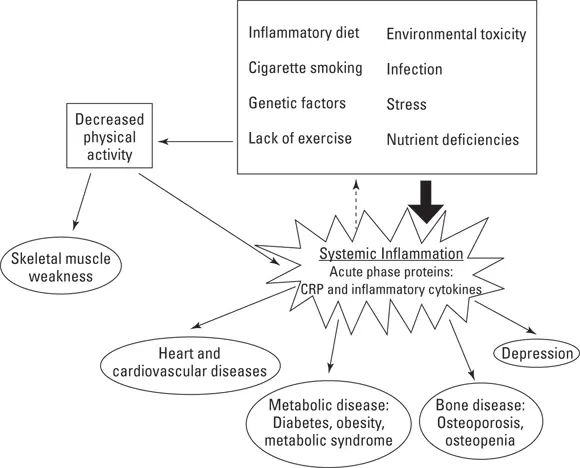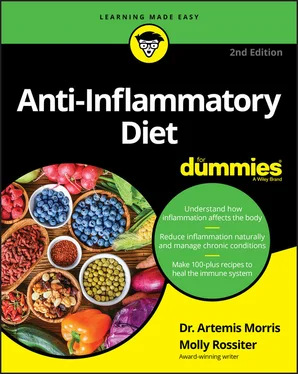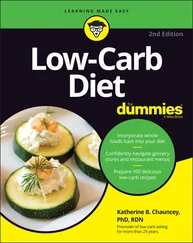1 ...8 9 10 12 13 14 ...18 Eat gluten-free whole grains. If you want to eat grains, be sure to reach for the ones that are least processed, such as steel-cut oats and sprouted grain bread. Refined grains lead to better gut health and can help to reduce inflammation.
Don’t forget the protein, fat, and carbs. Eating clean doesn’t mean eating only plant-based foods. Include some meats in your diet. Just be careful because processed red meat can actually trigger inflammation. Some good meaty protein sources include wild-caught salmon, tuna, and lean poultry.
Be sure to read the label. Although eating clean does involve eating mostly natural items, some packaged foods like nuts, some vegetables, and some meats are good, too. Just be cautious — read the labels and look for preservatives, added sugars, or the wrong kinds of fats (refer to Chapter 6where we discuss fats in greater detail). Some nuts are roasted in vegetable oil, for instance, and some pre-washed salads may come with processed cheese or fatty dressings.
 Clean eating isn’t always black and white; there is always room for flexibility according to your own needs and preferences. You don’t have to avoid any food groups — unless your doctor says you should — so keep in mind that moderation, even of the not-so-clean foods, can sometimes be okay.
Clean eating isn’t always black and white; there is always room for flexibility according to your own needs and preferences. You don’t have to avoid any food groups — unless your doctor says you should — so keep in mind that moderation, even of the not-so-clean foods, can sometimes be okay.
Chapter 3
Determining Inflammation’s Role in Chronic Diseases
IN THIS CHAPTER
 Connecting the dots between inflammation and chronic illness
Connecting the dots between inflammation and chronic illness
 Linking inflammation to heart disease, obesity, and diabetes
Linking inflammation to heart disease, obesity, and diabetes
 Looking at links to cancer, asthma, and bowel diseases
Looking at links to cancer, asthma, and bowel diseases
 Seeing inflammation in autoimmune disorders, neurodegenerative disorders, and depression
Seeing inflammation in autoimmune disorders, neurodegenerative disorders, and depression
The body is equipped to take care of itself in many situations, sending signals to create healthy inflammation levels where needed. Catch a cold, and the immune system instantly sends a message to the body to start fighting it off. Twist your ankle while hiking, and the area around it instantly starts to swell, creating a cushioned protection while the injury starts to heal.
Sometimes, however, the body’s defense mechanism works against itself, creating problems instead of solving them. Whether the signals get crossed or the process kicks into high gear, the body may fight itself when there’s no real reason to engage. The result of this overreaction is chronic illness in the heart, the nerves, the lungs, the joints — just about anywhere.
In this chapter, we examine a variety of chronic illnesses, from heart disease, asthma, and diabetes to obesity and problems with the digestive and immune systems. In addition to helping you gain a better understanding of these illnesses, we identify the role inflammation plays in each of them as well as what you can do to prevent or delay symptoms.
Understanding Chronic Diseases
Chronic diseases are those that aren’t communicable; that is, they’re not contagious. They’re usually long-lasting and don’t just go away on their own like a cold or the flu does. Chronic diseases include heart disease, diabetes, cancer, and arthritis — all diseases that invade the body and plan to stay. In addition, neurogenerative diseases, like Alzheimer’s disease, and even depression, are chronic illnesses that involve chronic inflammation at their root. Most chronic diseases are never cured completely, so your best bet is to avoid getting them in the first place.
 The Centers for Disease Control offer some interesting — and frightening — statistics regarding chronic diseases:
The Centers for Disease Control offer some interesting — and frightening — statistics regarding chronic diseases:
Chronic diseases are responsible for 7 of 10 deaths in the United States each year.
About 133 million Americans — about half the adults — live with at least one form of chronic illness.
More than 75 percent of healthcare costs can be attributed to chronic illness.
Inflammation is a common denominator among chronic diseases. Causes of inflammation — such as an inflammatory diet, cigarette smoking, chronic infections, daily stress, nutrient deficiencies, toxins, and lack of exercise — combined with genetic predispositions are a recipe for chronic disease.
Figure 3-1 shows how these factors can lead to systemic inflammation, which can later lead to chronic diseases such as heart and cardiovascular diseases, metabolic diseases (diabetes, obesity, metabolic syndrome), bone disease, and depression. Inflammation leads to low energy and makes you more prone to getting sick and moody, making you less motivated to exercise and further leading to skeletal muscle weakness and more inflammation.

© John Wiley & Sons, Inc.
FIGURE 3-1:The flow from risk factors to systemic inflammation to chronic diseases.
This cycle is self-perpetuating — unless you start to do something about it by changing your diet and lifestyle. Research has shown that dietary and lifestyle changes are more effective than any medication in reducing your risk of chronic disease and can prevent prediabetes from turning into diabetes. Keep in mind that changing your diet to stop inflammation isn’t just a temporary fix — it’s something you have to commit to following for the rest of your life.
Inflammation may be an underlying cause in multiple disease processes because it interferes with multiple body functions and even how your brain signals, called neurotransmitters, work. For example, leaky gut syndrome is a part of the mechanism by which food allergies, sensitivities, intolerances, and toxins play a role in the development of autoimmune diseases.
Autoimmune diseases are chronic diseases in which the body attacks itself through out-of-control inflammation. Besides genetics, dietary factors play a major role in autoimmune diseases. For example, studies have shown that people with certain types of autoimmune diseases, such as Sjögren’s disease and Graves’ disease, have a greater intolerance to gluten and a higher risk of developing celiac disease.
 A naturopathic physician can help identify causes of inflammation and why the body is attacking itself as well as help reduce the symptoms of many chronic diseases. Naturopathic medicine puts the focus on holistic medicine and proactive prevention — including good nutrition — and stresses the body’s ability to maintain and restore optimal health. Naturopathic physicians can diagnose the same way medical doctors (MDs) do but use natural healing agents. Although naturopathic medicine is a growing practice, naturopaths may still be in short supply in some areas. To find one in your area visit the American Association of Naturopathic Physicians website,
A naturopathic physician can help identify causes of inflammation and why the body is attacking itself as well as help reduce the symptoms of many chronic diseases. Naturopathic medicine puts the focus on holistic medicine and proactive prevention — including good nutrition — and stresses the body’s ability to maintain and restore optimal health. Naturopathic physicians can diagnose the same way medical doctors (MDs) do but use natural healing agents. Although naturopathic medicine is a growing practice, naturopaths may still be in short supply in some areas. To find one in your area visit the American Association of Naturopathic Physicians website, www.naturopathic.org .
Читать дальше

 Clean eating isn’t always black and white; there is always room for flexibility according to your own needs and preferences. You don’t have to avoid any food groups — unless your doctor says you should — so keep in mind that moderation, even of the not-so-clean foods, can sometimes be okay.
Clean eating isn’t always black and white; there is always room for flexibility according to your own needs and preferences. You don’t have to avoid any food groups — unless your doctor says you should — so keep in mind that moderation, even of the not-so-clean foods, can sometimes be okay. Connecting the dots between inflammation and chronic illness
Connecting the dots between inflammation and chronic illness The Centers for Disease Control offer some interesting — and frightening — statistics regarding chronic diseases:
The Centers for Disease Control offer some interesting — and frightening — statistics regarding chronic diseases:











